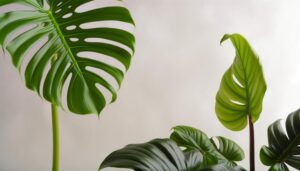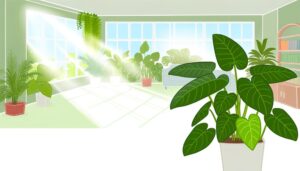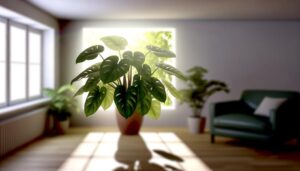What Is a Philodendron Erubescens Burgundy?
Philodendron Erubescens 'Burgundy', a member of the Araceae family, originates from Colombia's tropical rainforests. It features striking foliage with glossy dark green surfaces and luxurious burgundy undersides.
This climbing plant uses aerial roots to support its growth habit. Ideal conditions include bright, indirect light, temperatures between 18°C and 27°C, and humidity levels of 60%-80%.
Its well-draining soil should have a pH between 5.5 and 6.5. Key issues include leaf burn, etiolation, and root rot.
Propagation is typically achieved via stem cuttings or air layering. Discover more about its care and benefits in continuing sections.

Key Takeaways
- Philodendron Erubescens Burgundy is a tropical plant from Colombia with dark green leaves and burgundy undersides.
- It requires bright, indirect light and high humidity for optimal growth.
- The plant has a climbing habit and uses aerial roots to support its growth.
- It thrives in temperatures between 18°C to 27°C and prefers well-draining soil rich in organic matter.
- Known for its low maintenance, it also helps enhance indoor air quality and aesthetic appeal.
Origin and Background
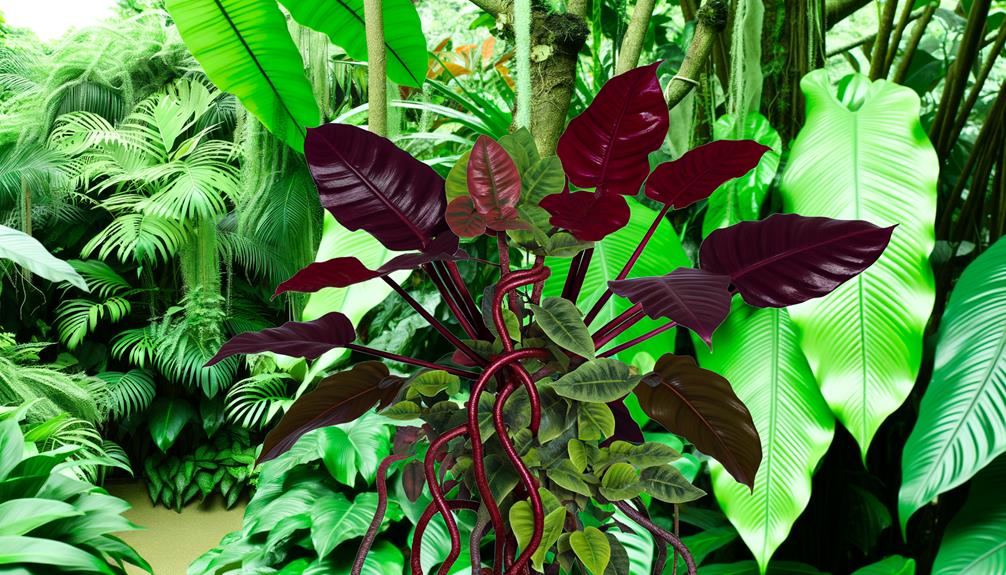
Philodendron erubescens 'Burgundy,' a member of the Araceae family, hails from the tropical rainforests of Colombia, where it thrives in the humid understory. This perennial plant flourishes in environments characterized by high humidity and indirect light, which mimic its native habitat.
The species is part of the genus Philodendron, known for its climbing growth habit facilitated by aerial roots that attach to nearby surfaces. The natural ecosystem provides ample organic matter, promoting the plant's robust growth. The temperature range in these regions typically remains between 15°C and 30°C, offering ideal conditions for its development.
Understanding its origin elucidates the necessity for replicating similar environmental conditions in cultivation to ensure optimal growth and health of Philodendron erubescens 'Burgundy'.
Unique Characteristics
Often distinguished by its striking foliage, the Philodendron erubescens 'Burgundy' features large, heart-shaped leaves that exhibit a rich, burgundy hue on the undersides, a characteristic attributed to the high concentration of anthocyanin pigments.
This perennial evergreen's vining habit facilitates its use as an ornamental climber in both indoor and outdoor settings. The leaves' upper surfaces are dark green with a glossy finish, adding to its visual appeal.
The plant's robust, aerial roots aid in nutrient absorption and structural support. Additionally, the 'Burgundy' cultivar is known for its moderate growth rate and resilience in various environmental conditions.
- � Luxurious burgundy undersides
- � Glossy dark green leaf surfaces
- � Vigorous aerial root system
- � Versatile vining habit
These characteristics make it a sought-after specimen for plant enthusiasts.
Ideal Growing Conditions
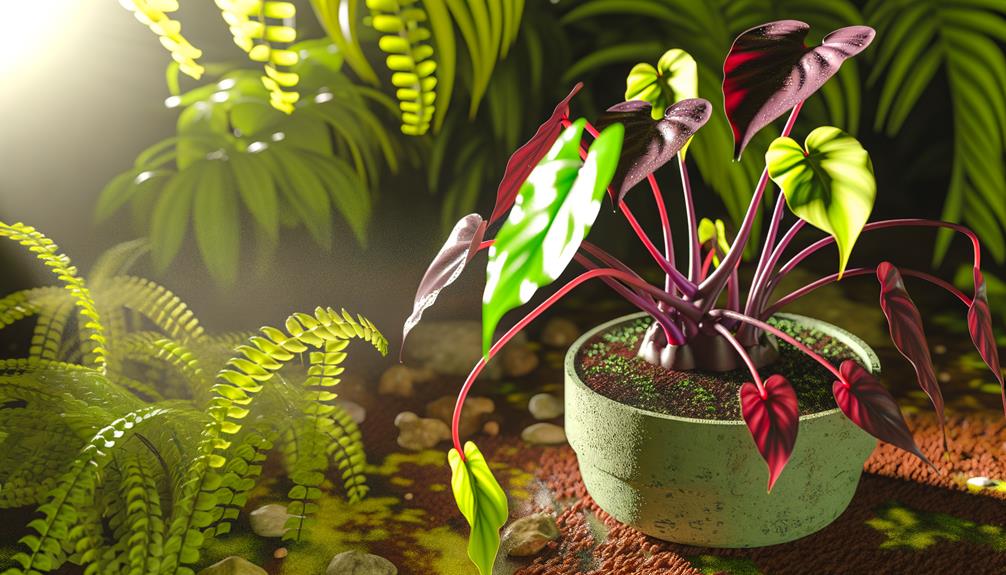
To maximize the growth of Philodendron erubescens 'Burgundy', it is essential to maintain appropriate light requirements, watering needs, and temperature preferences.
This species flourishes in bright, indirect light, avoiding direct sun exposure which can scorch its leaves.
Additionally, adhering to a consistent watering schedule and maintaining ambient temperatures between 18°C to 27°C will promote ideal growth conditions for this tropical plant.
Light Requirements
Ideal light conditions for Philodendron erubescens 'Burgundy' involve bright, indirect sunlight to mimic its native understory habitat in tropical rainforests. This species thrives when exposed to filtered light, which replicates the dappled sunlight penetrating the forest canopy. Direct sunlight can scorch the leaves, causing chlorosis and reducing photosynthetic efficiency. Conversely, insufficient light can stunt growth and result in leggy, etiolation-prone plants.
Providing the right lighting conditions is crucial for maintaining the Philodendron erubescens 'Burgundy' in top health.
- Vibrant, glossy foliage: Guarantees your plant displays its rich burgundy hues.
- Optimal growth rate: Maximizes the plant's aesthetic and structural development.
- Healthy, resilient leaves: Reduces vulnerability to pests and diseases.
- Enhanced photosynthesis: Boosts overall plant vigor and longevity.
Watering Needs
Maintaining consistent moisture levels in the soil is essential for the best growth of Philodendron erubescens 'Burgundy', ensuring the substrate remains evenly moist but never waterlogged. Overwatering can lead to root rot, a detrimental condition caused by fungal pathogens.
Utilize a well-draining potting mix, composed of components such as peat, perlite, and orchid bark, to facilitate ideal aeration. Water the plant thoroughly when the top inch of soil becomes dry to the touch, using distilled or rainwater to prevent mineral buildup.
Employing a moisture gauge can help in evaluating the soil's hydration status accurately. During the plant's active growing season, typically spring and summer, increase the watering frequency, while reducing it during the dormant period in autumn and winter.
Temperature Preferences
Philodendron erubescens 'Burgundy' thrives in temperatures ranging from 65°F to 80°F (18°C to 27°C), ensuring excellent metabolic and physiological functions. This temperature range supports best growth and vibrant foliage coloration. Consistency in temperature is crucial, as fluctuations can stress the plant, leading to reduced vigor and susceptibility to diseases.
Humidity levels should ideally be maintained between 60% and 80% to replicate the tropical environment native to this species.
- Vibrant, glossy leaves: Ensuring the plant remains lush and healthy.
- Reduced pest infestations: Stable conditions help in minimizing pest issues.
- Enhanced growth rate: Proper temperatures promote robust growth.
- Disease resistance: Favorable conditions bolster the plant's natural defenses.
Maintain these ideal parameters to cultivate a thriving Philodendron erubescens 'Burgundy'.
Light Requirements
How does the Philodendron erubescens 'Burgundy' thrive under different light conditions?
This aroid species flourishes in bright, indirect light, ideally mimicking the dappled sunlight of its native tropical understory habitat. Direct sunlight can cause leaf burn, evidenced by scorched, bleached foliage.
Conversely, low light conditions may lead to etiolation, where stems become leggy and leaves lose their vibrant burgundy hue. Best photosynthetic activity occurs under filtered light, promoting robust growth and vivid coloration.
Utilizing a sheer curtain or placing the plant near an east or north-facing window can achieve these conditions. Artificial grow lights with a full spectrum can also be employed, ensuring a consistent light source for maintaining its ornamental appeal and physiological health.
Watering Needs
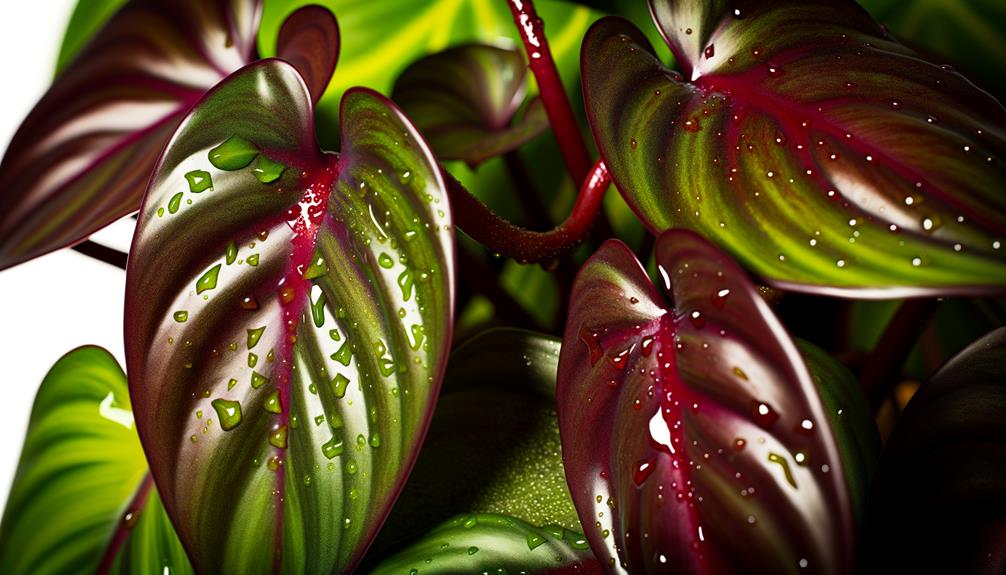
In addition to ideal light conditions, the Philodendron erubescens 'Burgundy' requires a carefully controlled watering regimen to thrive. This species necessitates a balance between hydration and aeration to prevent root rot and promote vigorous growth.
It is essential to allow the top inch of soil to dry out between waterings, making sure that the substrate remains consistently moist but not waterlogged. Utilizing well-draining pots can help facilitate this delicate balance.
- Root Rot Prevention: Making sure the substrate is not saturated reduces the risk of pathogens.
- Hydration Balance: Adequate moisture without waterlogging promotes healthy foliage.
- Environmental Humidity: Maintain 60-70% humidity for optimal growth.
- Water Quality: Use distilled or rainwater to avoid mineral buildup.
Employing these measures will optimize your Philodendron erubescens 'Burgundy' remains robust and vibrant.
Soil Preferences
Selecting the appropriate soil mixture is crucial for the health and growth of Philodendron erubescens 'Burgundy', with a preference for a well-draining, aerated substrate rich in organic matter.
The perfect soil composition includes a blend of peat moss, perlite, and orchid bark, which ensures sufficient moisture retention while preventing waterlogging. Peat moss provides essential organic nutrients and retains moisture, perlite enhances aeration and drainage, and orchid bark contributes to the substrate's structural integrity.
Additionally, the pH level should be slightly acidic, ideally within the range of 5.5 to 6.5, to facilitate optimal nutrient uptake. Incorporating compost or well-decomposed leaf mold can further enrich the soil, promoting robust root development and overall plant vitality.
Common Issues
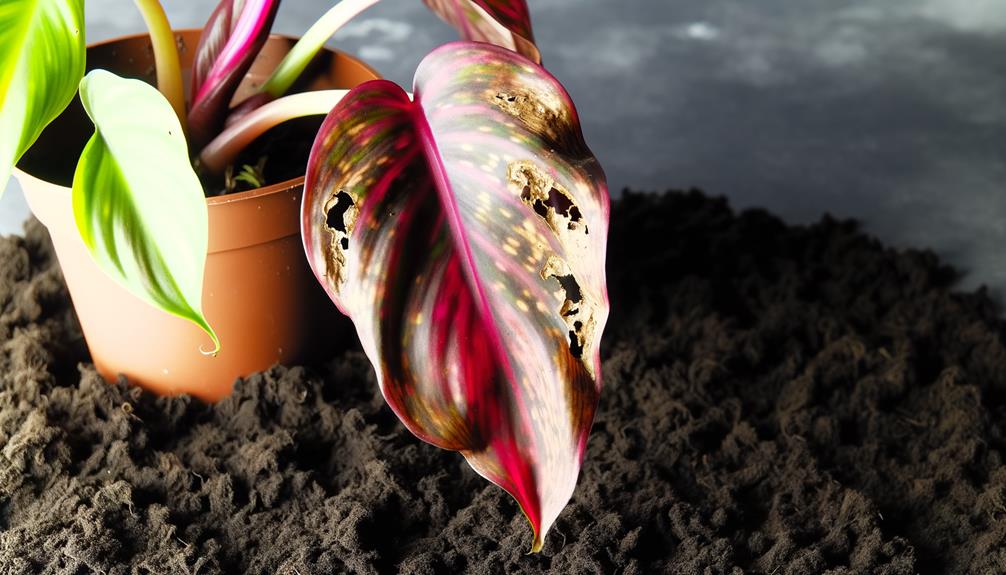
Despite careful attention to soil preferences, Philodendron erubescens 'Burgundy' may still encounter several common issues that can hinder its growth and health. These challenges often arise from environmental stressors and inadequate care practices.
Yellowing Leaves:
Chlorosis, often caused by overwatering or poor drainage, can lead to nutrient deficiencies.
Pest Infestations:
Common pests like aphids (Aphidoidea) and spider mites (Tetranychidae) can damage foliage and stunt growth.
Leaf Spot Diseases:
Fungal pathogens such as Phytophthora and Pythium spp. thrive in overly moist conditions, causing unsightly lesions.
Root Rot:
Excessive moisture and poorly aerated soil can lead to Rhizoctonia solani infection, resulting in deteriorating root systems.
Understanding these issues is essential for maintaining the robust health of your Philodendron erubescens 'Burgundy'.
Propagation Methods
Propagating Philodendron erubescens 'Burgundy' can be effectively achieved through methods such as stem cuttings and air layering, each offering distinct advantages for successful plant reproduction.
Stem cuttings involve excising a 4-6 inch section from a healthy stem, ensuring the presence of at least one node. This cutting should be placed in a moist, well-draining medium, such as a mix of perlite and peat moss, and kept in a high-humidity environment to stimulate root development.
Alternatively, air layering involves wounding a section of the stem, applying rooting hormone, and then wrapping it with moist sphagnum moss and plastic wrap. This method allows roots to form while still attached to the mother plant, ensuring higher propagation success rates.
Benefits of Growing
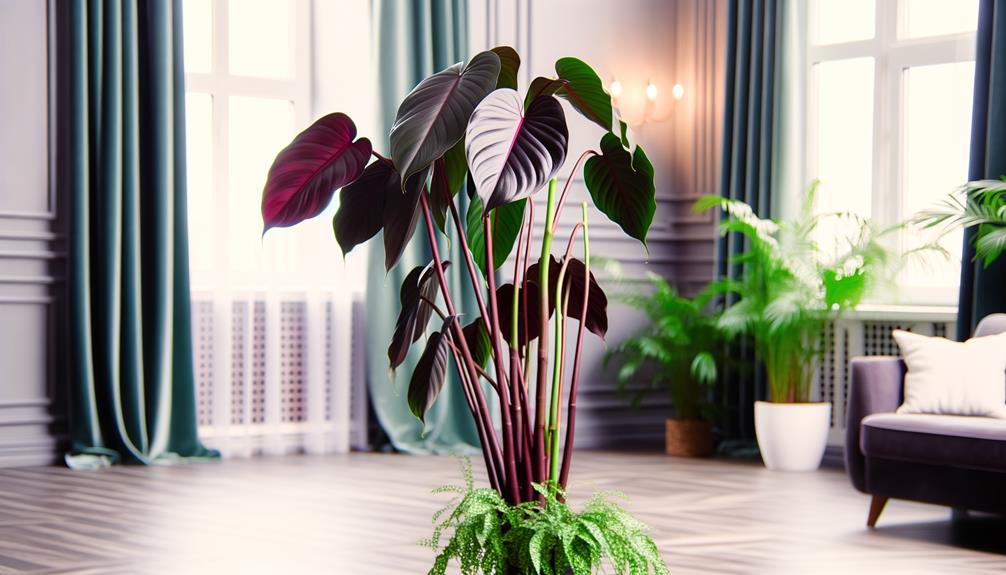
Cultivating Philodendron erubescens 'Burgundy' offers numerous horticultural advantages. One benefit is enhanced indoor air quality, as the plant's large, glossy leaves efficiently filter airborne toxins like formaldehyde and benzene. This contributes to creating a healthier living environment. Another advantage is the aesthetic appeal of the plant's striking burgundy foliage, providing a dynamic visual element that enhances interior design schemes.
Additionally, Philodendron erubescens 'Burgundy' has relatively low maintenance requirements. It thrives in moderate to low light conditions, making it suitable for various indoor settings. Some key benefits of cultivating this plant include its air purification qualities, visual impact, ease of care, and versatility. It reduces common indoor pollutants, adds elegance and vibrant color, requires minimal watering, and can tolerate lower light levels. Its adaptability makes it suitable for offices, homes, and even shaded outdoor areas.
Conclusion
Philodendron erubescens 'Burgundy' presents a striking cultivar with its dark, vibrant foliage, ideally suited for indoor cultivation. With appropriate care, it can thrive, contributing to air purification and aesthetic enhancement.
An intriguing statistic reveals that indoor plants can reduce airborne dust levels by up to 20%, accentuating the practical benefits of cultivating such species.
Mastery of its specific light, water, and soil requirements guarantees robust growth and minimized common issues, making it a valuable addition to plant collections.


